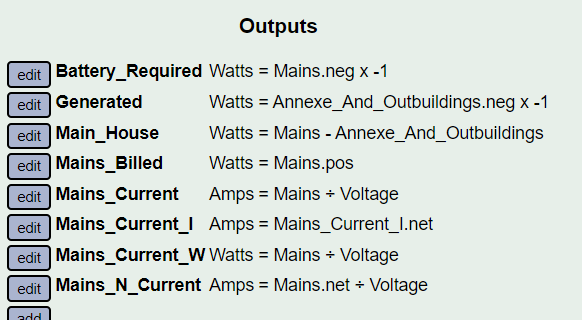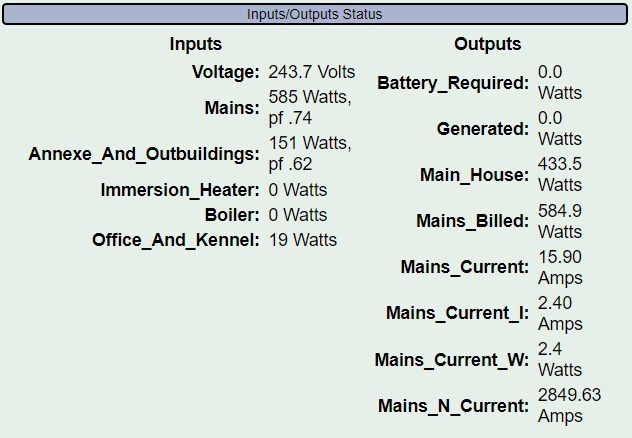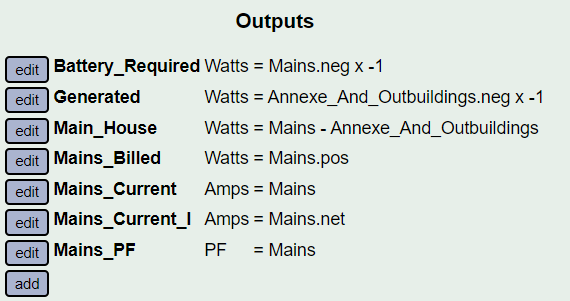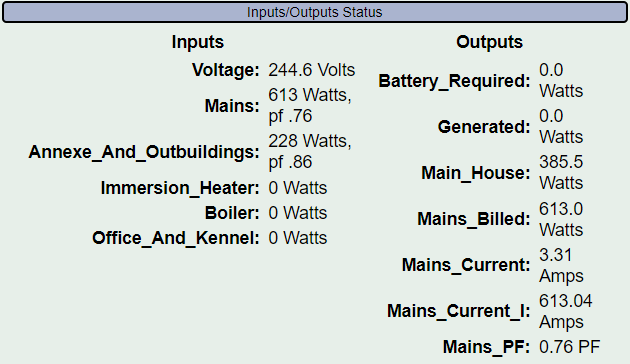I’ve been using my IotaWatt but I’ve just noticed a couple of issues with the numbers.
The first is general accuracy - We’ve just had a smart meter installed which can report the live voltage and current. The voltage reported by the IotaWatt seems to be spot on (Within a couple of hundred millivolts) but the over-all power seems to be off by about 20%. What is the expected accuracy?
The smart meter was reading about 240V and 2.2A which should be around 530W, but the IotaWatt was reporting around 400W. (UK / Single phase) The over-all power usage seems to be in the right ballpark though, so is it just an issue with smaller values?
My second issue is around calculations and trying to work out the current - I need the current as I’m trying to work out my maximum demand in order to notify the DNO about a heat pump install.
A picture is a thousand words, so here are some pictures of the configuration and the values. (Some are combined in an odd way due to how the buildings are wired, but Mains is exactly what you’d expect - Just a single CT on the incoming supply right after the meter.)




As you can see, I created a load of current outputs and even an integrator when I realised I was getting some weird values. You’ll notice that just changing the output type between Watts and Amps for Mains_Current and Mains_Current_W results in a wildly different value for the same calculation. Mains_Current_W and Mains_Current_I look to be correct, but both have incorrect units set. (Mains_Current_I is based on a Wh integrator)
Am I missing something with these calculations?
Definitely. You are conflating Watts and VA. I’m not going to try and explain it here, just read through this excellent tutorial at the Open Energy Monitor site.
Your IoTaWatt should be measuring power (Watts) and energy (Wh) at 1% accuracy or better. However, whenever I see someone using YHDC SCT013-000 I have to pause and caution that while this is a good CT, there are several variants that look identical but are not compatible. Specifically the model supported is marked SCT013-000 100A:50mA. Other models are marked SCT013-nnn where nnn is the maximum current like 060, 030, even 005. They are also marked nnnA:1V. Moreover there are counterfeit SCT013-000 that are reported to be wildly inaccurate. If you post a picture of the nameplate side I can attempt to authenticate your CTs.
Ah thank you, that makes a lot of sense as the power factor was 0.74 in my picture. I’ll have another look at the meter tomorrow but as I understand it, the voltage * current (VA) from the live meter readings is the apparent power which must be multiplied by the power factor in order to get the real power (W) which I’m billed for and which the IotaWatt reports?
In that case, I think I need the following calculation in IotaWatt to get the current:
Current = RealPower / PowerFactor / Voltage
I see now that the output units tries to do this conversion for me. It does however appear to be acting strangely if I try to use an integrator rather than an input.


Mains_Current appears to be correct: 613W / 0.76 / 244.6V = 3.30A
I have no idea what’s going on with Mains_Current_I - Do I need to use the “net” property of the integrator in this scenario? (We have solar so Mains is often negative)
The CT was purchased from OpenEnergyMonitor back when you sold the IotaWatt through there so it should be genuine, here’s a picture:
The fundamental metrics measured by IoTaWatt are Voltage and Current. Everything else is derived from those. Trying to work backwards to get Amps makes no sense. If IoTaWatt says the Mains Amps is 3.31, then that’s what it is.
I’m not clear on why you are using integrators. In any event they only integrate Wh and you can’t get Amps from them.
Yes, that looks like a bona-fide SCT013-000.
Sorry I got confused with the integrator, I had it in my head that it was needed whenever there were negative values but I’d forgotten that it was only for the integration of the value - The clue is in the name I guess! I also wasn’t fully clear on the units options of the outputs but again that now makes sense.
But this all makes a lot of sense now, the numbers look to be correct and I can confirm the readings against my smart meter tomorrow but the difference I had been seeing now makes sense to me.
Thank you for your help, I really appreciate it.
1 Like
I’ve just confirmed that against the smart meter, it’s reading within 10mA so all is good.
Thanks again.






